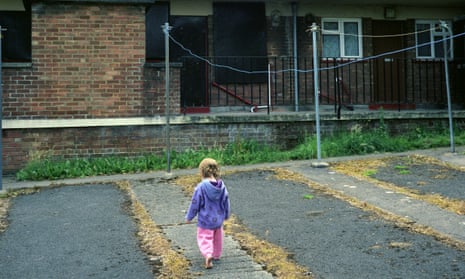The number of children and pensioners in absolute poverty increased in 2017-18 as inflation and accommodation costs took a bigger chunk out of household finances, according to figures from the Department for Work and Pensions.
Inequality also jumped in response to rising incomes among the richest workers and the second year of a benefit freeze that hit low-incomes households, the DWP said.
Anti-poverty groups called for government action to reverse the trend, which most analysts believe has worsened since last April. They expect it to worsen further under government policies, with poverty and inequality increasing until the middle of the next decade.
The TUC general secretary, Frances O’Grady, said low pay, insecure work and the benefits freeze was trapping families below the breadline. “We need to redesign the economy to make it fair again. People need more control over their working lives and a fairer share of the wealth they create,” she said.
A household is considered to be in relative poverty if their income is below 60% of median income of £507 a week in 2017-18, while they are in absolute poverty if their income is below 60% of the 2010-11 median income, adjusted for inflation.
The latest figures show the number of children living in absolute poverty increased by 200,000 in 2017-18. Relative child poverty also increased before housing costs, and fell slightly after housing costs.
As a result, 30% of children, or 4.1 million, were living in relative poverty (after housing costs) in 2017-18 in the UK and 70% of children living in poverty were in working families.
The percentage of pensioners in relative poverty before housing costs rose from 17% to 18% between 2016/17 and 2017/18.
The Resolution Foundation thinktank said the recent increase in child poverty had been primarily driven by the freeze in the value of working-age benefits, made worse by a spike in inflation to 3% in late 2017.
Adam Corlett, a senior economic analyst at the Resolution Foundation, said: “With the bulk of the government’s £12bn of welfare cuts taking place 2017-18, child poverty is likely to continue rising and could even hit a record high within the next few years.
“The political conversation around austerity may have shifted but the lived experience of it hasn’t for millions of families. Reducing child poverty needs to return to near the top of the government’s priority list,” he added.
Research carried out for the Child Poverty Action Group found that a four-year freeze on children’s benefits due to run until next year will lead to average loses of £240 per year for families with children. It will also result in 100,000 more children in poverty by 2023-24.
A government spokesperson said tackling poverty remained a priority and it took the numbers “extremely seriously”.
The spokesperson added: “We know some families need more support, which is why we continue to spend £95bn a year on working-age benefits. We are looking at what more can be done to help the most vulnerable and improve their life chances.”
Housing costs have become an increasing factor in measures of inequality over the past 30 years as house prices and rents relative to average incomes have risen by three times the rate of inflation.
Separate figures from the Office for National Statistics examining housing affordability showed the number of children in poverty due to rising housing costs has increased over the past 10 years.
Analysis of ONS data by the National Housing Federation (NHF) revealed that there are 847,000 children from working families living in poverty for the sole reason that their homes are too expensive. This is a 30% increase - 193,000 children - since 2010.
The number of children pushed into poverty before housing costs are factored in has increased by 287,000 children, it said.
Rising rents and a shortage of affordable housing in large parts of the country are being blamed for the problem. The average household in poverty would be about £3,172 a year better off in social housing when compared to renting privately. This is equivalent to a year’s supply of food for the average family, the NHF has calculated.
“We are now seeing the full effects of the housing crisis and a direct link between the lack of affordable homes and in-work poverty,” said Kate Henderson, the NHF’s chief executive.
“There could not be a clearer signal to government that the country desperately needs more social housing – direct investment in the upcoming spending review is the only way to provide truly affordable homes for these families. This is more crucial than ever in the midst of Brexit uncertainty.”
